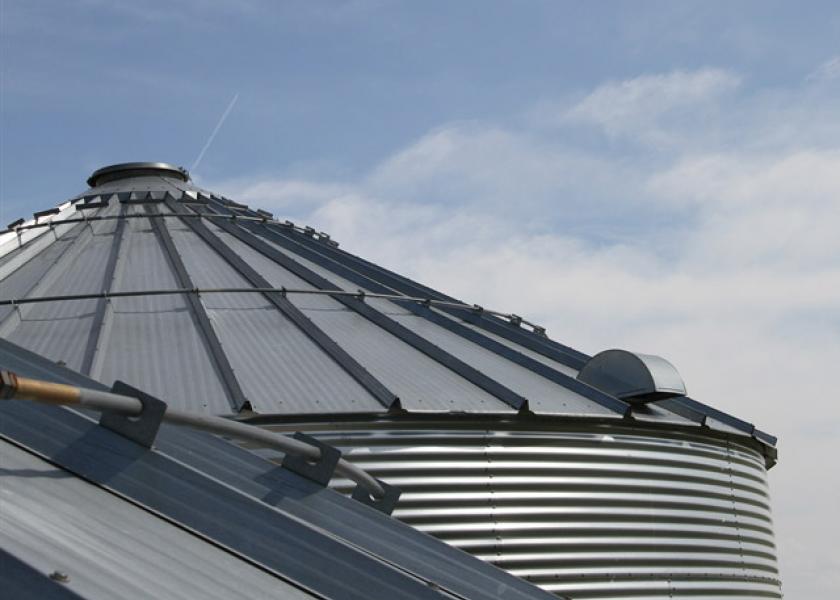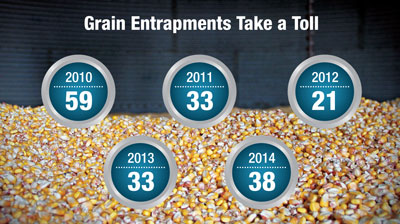A Steady March of Grain Bin Deaths

Impulse often trumps experience in grain accidents
Bodie Blissett stepped away from the madness of harvest into the deceptive calm of a northeast Mississippi grain bin. A tower of corn climbed the bin wall, lazy and friendly at the sloping bottom, rigid and deadly at the top. He jammed a shovel into the tapered base of the corn pile, unleashing a Jericho drop of grain. In seconds, the corn transformed from a vertical wall to a horizontal blanket, burying Blissett to his neck.
A few more inches of grain and Blissett would have suffocated. Five hours later he was dug out by rescue crews. “I don’t even recall how high the corn was. It came down and got me with no warning. Too fast, too much, and I don’t like remembering it,” Blissett says.
Despite mounting awareness campaigns, grain bin accidents continue, with 2010 ranking as the most hazardous year on record, according to Purdue University: 59 entrapments and 26 deaths. There were 33 entrapments and 13 deaths in 2013, and 38 entrapments and 17 deaths in 2014.
The overall trend shows a slightly increasing number of grain incidents on farms, says Bill Field, professor of agricultural health and safety at Purdue University. He has been collecting grain accident statistics since 1978 and points to a direct correlation between grain stored wet and increased likelihood of entrapment. The 2009 corn crop went into storage immature and relatively wet—setting the stage for record entrapments in 2010.
“Entrapments and engulfments go up as bins go up,” says Davis Hill, program director, Managing Agricultural Emergencies at Penn State University. “More bins on farmland mean more opportunities for these incidents.”
Technically, a grain entrapment occurs when a victim is buried in grain beyond self-extraction. In a grain engulfment, the victim is entirely covered beneath grain. Half of grain entrapments lead to engulfments, which are almost always fatal, Field says.
More than half of accidents are in stored corn, with some in soybeans, wheat and other crops.
The vast majority of grain accidents involve attempts to dislodge crusted grain. In most cases, the farmer is alone, without a rope or harness, and nothing to grab as the descent begins. Extraction can take hours or days if a body is stuck at the bottom of a 50,000-bu. bin.
There is also tremendous danger in grain along bin walls. The slightest shift can cause a cascade, as in Blissett’s case. Wet grain or a leak in the bin top can produce a seemingly solid mass, waiting to collapse.
Beyond bins, Field has recorded 140 deaths related to grain transport boxes—mainly children riding atop grain loads and being sucked in as gates are opened. It’s a category with an incomparable impact on farm families: 95% of victims are boys with an average age of 11. “There’s no way to describe the devastation,” Field says.
Safety discussions must begin with proper grain management in storage. “Store grain at 14% or less moisture and manage it in tight bins. Nobody will die because it will come out. Store grain at 17% to 18% and hit a warm spell? The grain will clump and somebody might get hurt,” he says.
Even with training and awareness, danger is always lurking. Field cites an Illinois fire department undergoing grain bin rescue training. The assistant fire chief, also a farmer, suffocated in a grain bin just weeks after the training session. The bitter irony highlights the time pressures of harvest—impulse can trump experience.
“Never place a greater value on a crop than on yourself and your family,” he warns.
 |
Safety discussions should begin with grain storage, and the top safety factor is proper management, says Bill Field, professor of agricultural health and safety at Purdue University. |







